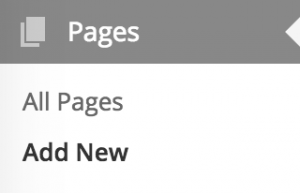5.0 Intro
In WordPress, you can put content on your site as either a "post" or a "page". When you're writing a regular blog entry, you write a post. Posts, in a default setup, appear in reverse chronological order on your blog's homepage.
In contrast, pages are generally for non-chronological, hierarchical content: pages like "About" or "Contact" would be common examples. See below for examples of subpages in a hierarchy. Pages live outside of the normal blog chronology and are often used to present timeless information about yourself or your site -- information that is always relevant. You can use Pages to organize and manage the structure of your website content.
In addition to the common "About" and "Contact" pages, other examples include "Copyright", "Disclosure", "Legal Information", "Reprint Permissions", "Company Information" or "Accessibility Statement".
In general, pages are very similar to posts in that they both have titles and content. WordPress Theme template files maintain a consistent look throughout your site. Pages, though, have several key distinctions that make them different from posts.
What Pages Are
- Pages are for content that isn't specifically time-dependent, or which isn't "blog content".
- Pages can be organized into pages and subpages.
- Pages can use different Page Templates, including template files, Template Tags and other PHP code.
- More sophisticated themes may provide a wider range of adjustments or display options for individual pages.
- It's quite possible to make a website using WordPress which only contains pages.
What Pages Are Not
- Pages are not posts, so they don't appear in the time-structured views within a blog section of a website.
- Pages cannot be associated with Categories, but they can be assigned Tags. However, Tags on Pages are not included in lists displayed via the "tag" permalink.
- The organizational structure for Pages comes from hierarchical interrelationship, not from a system of categorization. (e.g. Tags or Categories.)
- Pages are not files. They are stored in your database, just like posts.
- Although you can put Template Tags and PHP code into a Page Template file, you cannot put these into the Page or Post content without using a WordPress Plugin. But be careful: integrating PHP code directly into page or post content may introduce a security problem, or an unexpected error on your website.
- Pages are not included in your site's "feeds". (e.g. RSS or Atom.)
- Pages and Posts can be interpreted differently by site visitors and by search engines. Commonly, search engines place more relevance to time-dependent site content - posts - because a newer post on a topic may be more relevant than a static page.
- A specific page (or a specific post) can be set as a static front page. Websites which are set up in this way usually have a secondary page defined on which the latest blog posts are displayed.
Creating Pages
To create a new Page, log in to your WordPress installation with sufficient admin privileges to create new pages. Select the Pages > Add New option to begin writing a new Page.
